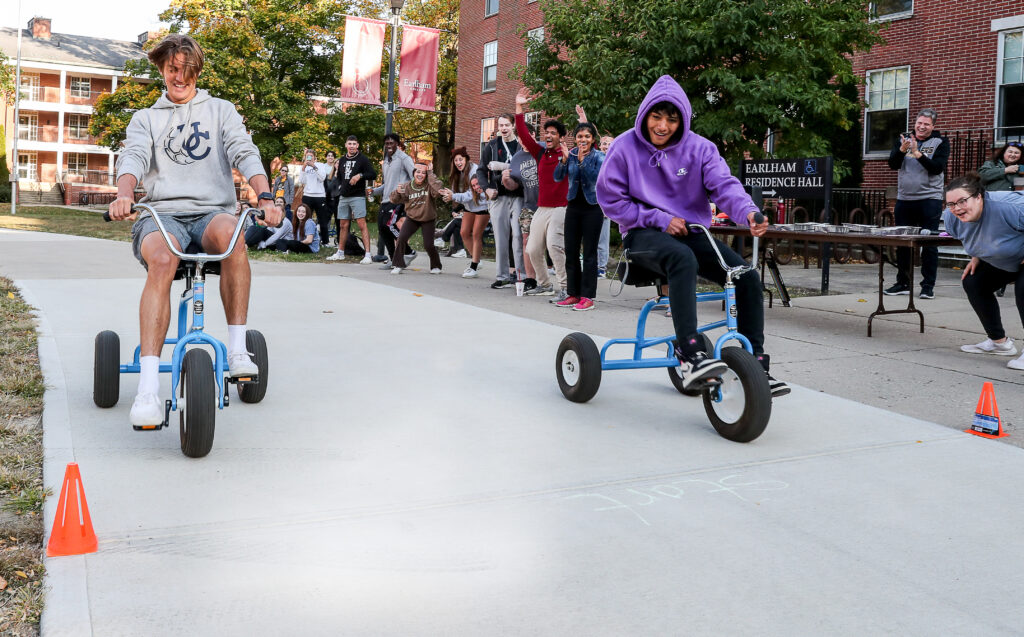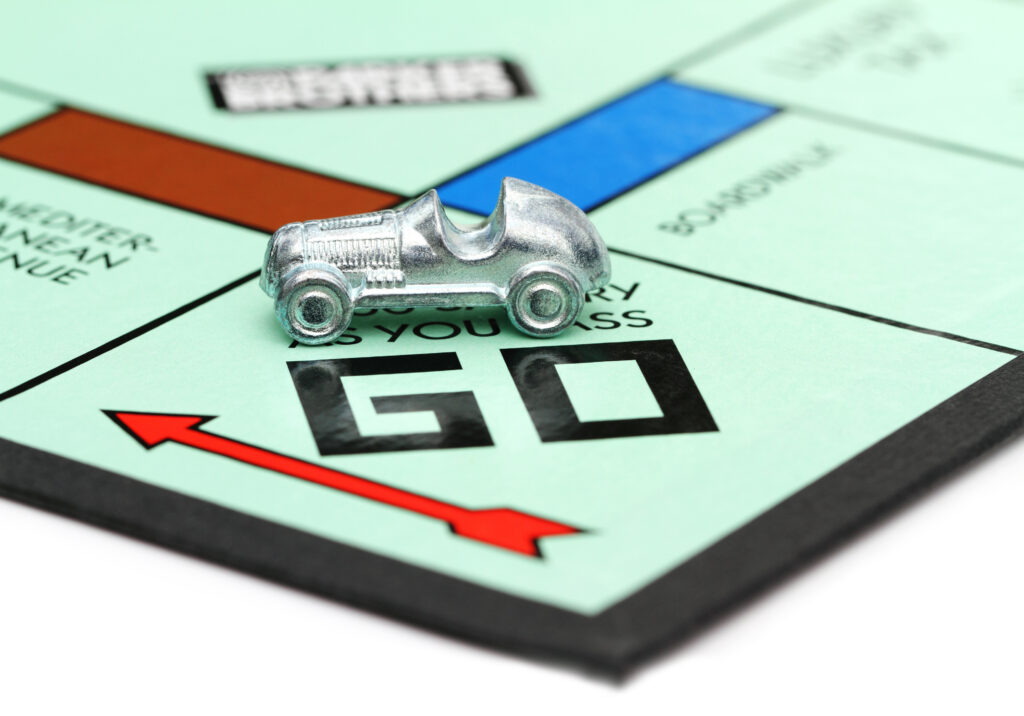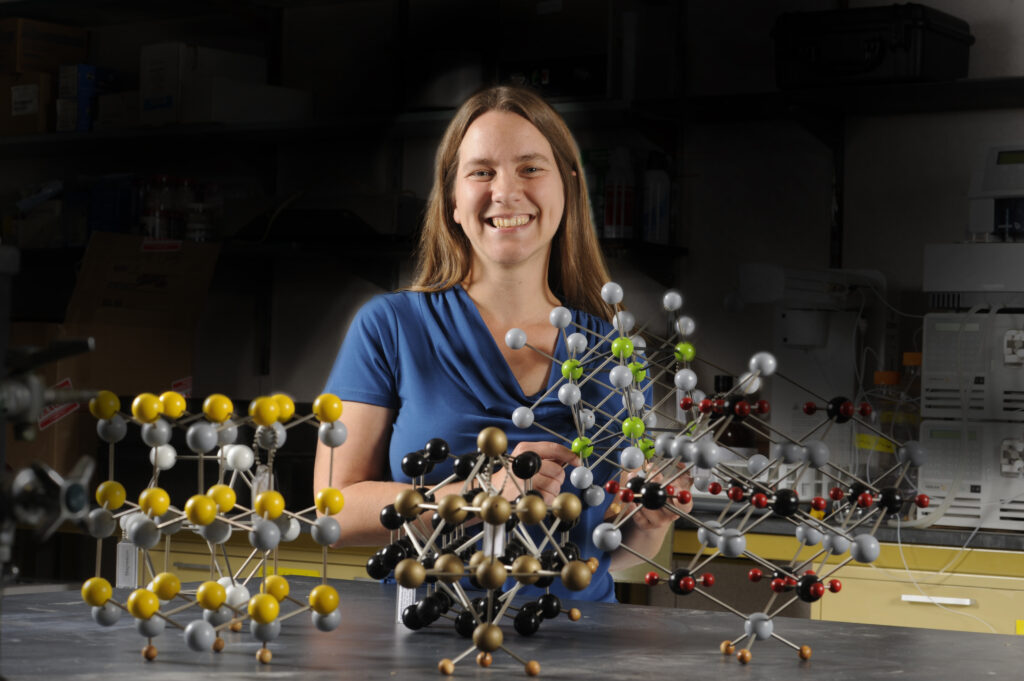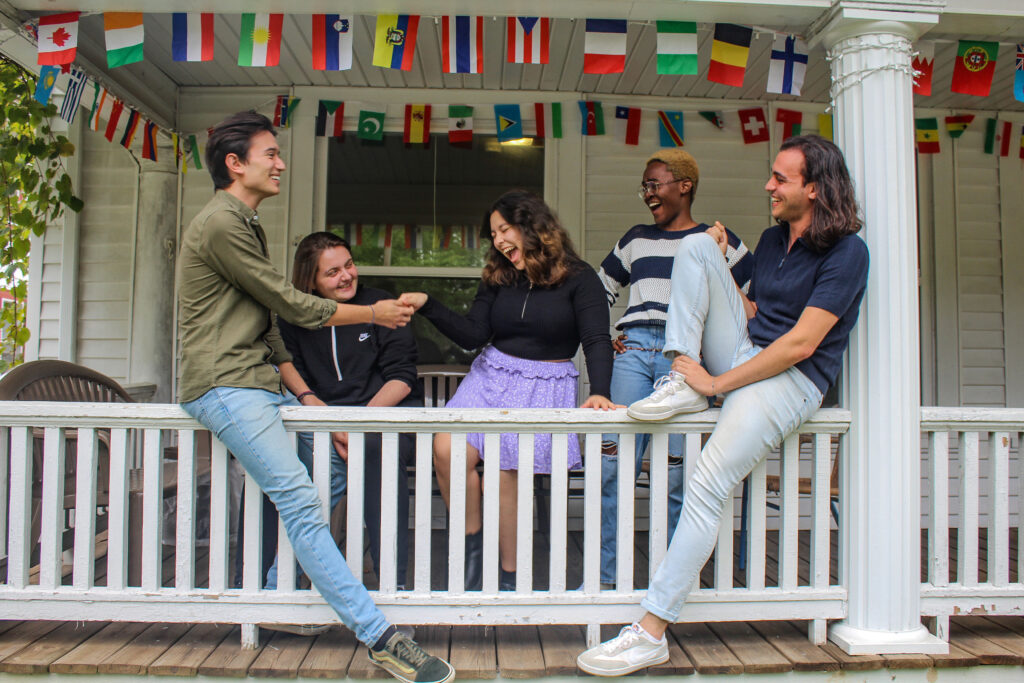Return of the Bundy 500

First-year students Orin Gentner and Andre Moriel cross the finish line for the reimagined Bundy 500 in front of Earlham Hall. Participants went through a series of challenges including a tricycle race, obstacle course, “bobbing for bugs,” and trivia contest. Moriel not only won the tricycle race, he was the overall winner, clinching his victory with “Liberty, Equality, Bundity” as the answer for Bundy Hall’s motto.
Regan Seeman ’22, current hall directorfor Bundy, brought the idea for reviving the Bundy 500 to Hannah Turner, her residential life area director. “The history of the Bundy 500 was just too good of a thing to pass up,” said Seeman. After ruling out using real cockroaches, the two put their heads together to find another way to pay homage to the original race. There are now hopes to add the race to the homecoming schedule every year so that alumni can also watch.

Mary Asch ’24, daughter of Bill
’93 and Emily ’94 Asch, broke out
her dad’s Bundy 500 shirt from
1990 in honor of the occasion.
Earlhamites behind Monopoly
Before you roll dice to see who goes first in your next game of Monopoly, just know that you have some bragging rights, Earlhamites. Unfortunately, this won’t save you from the agony of landing on a hotel occupied Boardwalk.
Several of your fellow Earlham alums were instrumental in developing the game that has sold billions.
As a child in the early 1930s, Dorothy Leonard ’46 lived on Pennsylvania Avenue in Atlantic City. Her parents Ruth ’23 and Cyril Harvey ’22 played a game they called Monopoly with another couple, Dorothea and Jesse Raiford, both from the Class of ’23, who lived at nearby Marven Gardens. (Yes, that’s spelled correctly, Monopoly aficionados.)
Also joining them was Ruth Hoskins ’25. The Raifords, Harveys and Hoskins were all young teachers in and around Atlantic City working at an area Friends school.
It was Hoskins who introduced the game to the others. She had learned an earlier version of the game while in Indianapolis. The Earlhamites’ game was a derivative of an earlier auction/bidding game called Landlord that was patented in 1902 by Quaker Elizabeth “Lizzy” J. Magie Phillips.
With all due credit to Lizzy, Monopoly would find greatest glory, not Landlord. Hoskins and the others altered the rules and created a different layout. They introduced purchasing properties at set prices instead of bidding. They also changed the Indianapolis place names to Atlantic City landmarks like Baltic, Mediterranean, Boardwalk, Pennsylvania Avenue, and Marven Gardens (later misspelled by Parkers Brothers).
Their version of the game spread from house to house.

“Charles Darrow, who we can imagine twirling his mustache at this moment in the story, recognized Monopoly’s commercial value and approached Parker Brothers about marketing it. They rejected the game, but Darrow was undaunted. Unemployed at the time, he decided to produce it on his own.”
Dorothy Leonard’s mother used personal objects like rings, thimbles and tie tacks as game pieces. The participants did not tell everyone they played because Quakers were not supposed to use dice.
Game boards were made of oilcloth, and friends loaned Monopoly oilcloths to other friends.
Rules traveled by word of mouth.
The Raifords told their friends, the Todds, and the Todds told the Darrows.
Charles Darrow, who we can imagine twirling his mustache at this moment in the story, recognized Monopoly’s commercial value and approached Parker Brothers about marketing it. They rejected the game, but Darrow was undaunted. Unemployed at the time, he decided to produce it on his own. With help from a printer, Darrow sold 5,000 handmade sets of the game to a Philadelphia department store. People loved it, and he couldn’t keep up with demand. He went back to the Parker Brothers and the rest is history, not that the Earlhamite innovators saw any reward.
“The worst part is Darrow stole it from his friends,” said Leonard to the Atlantic City Press in 1989. “These were quiet Quakers. They didn’t believe in suing and seeking attention. They trusted that someday he would be caught and left it at that.”
But Darrow never drew the “Go to Jail” card.
Those twists of history were a bitter irony to the game’s Earlhamite developers, but on Sept. 11, 1989, the survivors of the original game developers were guests of honor at a reception in Atlantic City. They were presented with a plaque “Honoring the Truth About Monopoly” that read: “In 1931 the Game Now Sold as Monopoly Was Actually Invented In and Around The Atlantic City Friends School Which Once Stood On This Spot. The Invention was a Cooperative Effort Centered on Ruth Hoskins, and Jesse Raiford, Cyril and Ruth Harvey.”
In its first year, 1935, Monopoly became the best-selling game in America. Over its 80-year history, more than a billion people have played it.
A group of Earlham Quakers had a hand in that. Remember their story the next time you break out the race car, top hat and thimble.
EDITOR’S NOTE: A version of this story was written by retired reference librarian Steve Martin of Richmond, Indiana. It was originally published in the Palladium-Item.
Affordable learning champ

Professor of Chemistry Lori Watson has been recognized as a leader in the PALSave textbook affordability initiative sponsored by the Private Academic Library Network of Indiana (PALNI). The program promotes the use of free, open-course materials and library e-books. Watson is one of 10 participants across the state awarded an Open Educator Award for the 2021-22 academic year.
35
NUMBER OF EARLHAM FACULTY MEMBERS WHO HAVE ATTENDED WORKSHOPS, REVIEWED OPEN ACCESS TEXTBOOKS OR ADOPTED ALTERNATIVE COURSE MATERIALS SINCE 2019.
Nearly 40%
PORTION OF EARLHAM’s STUDENT BODY HAS BEEN IMPACTED.
Lilly Library
FOUNDING MEMBER OF PALNI. EARLHAM LIBRARY DIRECTOR AMY BRYANT REPRESENTS THE COLLEGE ON PALNI’S BOARD.
Bones and drones
Faculty from the Earth and Environmental Studies Department have successfully implemented a new way to quickly locate fossils buried in the 16-million-year-old bedrock in the Mojave Desert.
Using GPS and drone technologies last summer, Andy Moore and Shannon Hayes worked with students to scan the desert surface from the air and created 3D digital models that helped identify new fossil locations in about a half hour. It was great news for paleontologists from the Western Science Center in Hemet, California, sponsors of the project. They had exhausted their resources.
“Historically, paleontologists have returned to locations in the desert where fossils have already been found. The spiky vegetation and steep terrain make this a hard place to work and it’s very time consuming,” said Moore, a professor of earth and environmental science, leader of the pilot program.
“We’ve discovered that you can use photogrammetry to digitally model and manipulate the landscape in 3D to identify continuations of fossil-bearing rock in areas that are difficult to see from the ground,” he said.
The Western Science Center is eager to continue their research on the ancient ecology of southern California and expand their collections.
“We were thrilled to find prehistoric camel and three-toed horse bones in a new location identified using our preliminary digital model,” said Hayes, Earlham’s geology curator, and a co-leader on the trip.
Moore and Hayes expect to return to California in future years to continue the work.
More online
Our faculty members are out in the world doing outstanding things. From publishing novels, to presenting groundbreaking research, they’re always working to make the world better.
I-20 House debuts

Named after the form that international students must complete to study in the United States, the I-20 House has quickly become a hub for engagement for the 20 percent of Earlham’s student body who come from outside the United States.
“Earlham is already a strong educational community, but we believe that we can become even stronger,” said Ahmed Deeb, a senior from Palestine who is one of five international students who established the I-20 House with the Office of Residence Life. His housemates include students from Costa Rica, Angola, Kosovo and Portugal.
“Our main focus this year is to make sure the first-year students are having an experience without the struggles most international students are facing,” Deeb said. “We want to make the resources that are available to international students more visible. If they feel homesick or need help, this is a space where everyone can come and ask questions.”
The I-20 House joins the International Student Office, Office of International
Admissions and the Multicultural Resource Center as centers of support for Earlham’s international students.
Other living-learning communities that connect students from multicultural
backgrounds include Asian American Pacific Islanders House, Latinx House, Interfaith House and the African/African American House that are available to students beginning in their second year.
Summer immersion program returns
Earlham College has been awarded a nearly $1 million grant from Lilly Endowment Inc. through its Indiana Youth Programs on Campus initiative to launch a summer immersion experience for high school students. The grant is part of a statewide investment to help young people in Indiana experience higher education programs that help them explore their interests and envision a future for themselves in college.
Earlham Summer, a pre-college program for high school students will serve up to 120 high school sophomores, juniors and seniors during two weeklong immersive experiences on campus, beginning June 2023. The new program is a successor to Explore-a-College, previously hosted by Earlham.
Participants will take classes led by Earlham faculty, learn about the admissions process, and stay overnight in campus residence halls. Students will also learn about new scholarship opportunities that are available to Indiana students, including INspire Earlham, a free tuition program for students from low- and moderate-income backgrounds. Transferrable college credits will be awarded to students who complete the program.
Lilly Endowment funding will make this opportunity available to Indiana families at little to no cost. A major gift from Earlham alumni Tom ’57 and Nancy Newlin ’56 will expand the program to a national audience by summer 2024 and support the long-term success of the program.
More online
The Earlham Summer program is giving Indiana high school students the opportunity to experience college life before they have to send in their applications. Encourage the high-schooler in your life to consider this once-in-a-lifetime opportunity!
“Earlham gave me versatility so I can go between fields. I know I can learn whatever I need to.”
Young alum spotlight
Arish Mudra Rakshasa-Loots ’19 recently moved to Edinburgh, Scotland, to continue his Ph.D. research on the causes of high rates of depression among those living with HIV and AIDS. A catalyst for his research interests was a course he taught as an Earlham student called Condom Sense: HIV/AIDS in the 20th Century. “Everyone was very supportive of me leading this course and happy about the value that it added to the biology course offerings that semester,” Mudra Rakshasa-Loots remembers.
Mudra Rakshasa-Loots chose to attend the University of Edinburgh for his doctorate. so he could pursue his research in translational neuroscience. After he completes the program, he plans to apply for research positions, as well as teaching positions at liberal arts colleges.
“Earlham encourages generalization rather than specialization,” he says. “It’s still hard to be a generalist in a specialized field, but Earlham gave me versatility so I can go between fields. I know I can learn whatever I need to.”
Science scholars
The College has been selected for a six-year grant from the National Science Foundation to establish a new career planning and discernment program for students in STEM who are eligible for Pell Grants.
The Earlham Science Scholar program will provide up to $10,000 per year in scholarships to income-eligible students pursuing a bachelor’s degree. Scholarship recipients will also receive a paid Earlham summer research experience, a stipend to attend a scientific conference and specialized mentorship from STEM faculty and the College’s Science and Environment Career Community.
Cohorts of five students will be selected for the program for the next three years.
ACADEMIC MAJORS SUPPORTED BY THE PROGRAM INCLUDE:
ENGINEERING, BIOLOGY, BIOCHEMISTRY, COMPUTER SCIENCE, EARTH AND ENVIRONMENTAL SCIENCE, MATHEMATICS, DATA SCIENCE, PHYSICS
$747,247
GRANT FROM THE NATIONAL SCIENCE FOUNDATION
FALL 2023
EARLHAM SCIENCE SCHOLAR PROGRAM BEGINS
Earlham wins at Arabic debate
A team from Earlham College went toe-to-toe with students from some of the largest and most prestigious universities from around the nation at the U.S. Universities Arabic Debating Championship at Stanford University held earlier this fall.
The Earlham team participated in four debates, taking home best speaker individual awards in three of them. It was the first time that Earlham had sent a team.
“We were definitely underdogs—one of the only private liberal arts colleges there,” said junior Ihsan Alaeddin. He suspects that the other teams didn’t expect much of them.
Alaeddin was joined by senior Ahmed Deeb and sophomores Zain Hammad and Yara Matar. Ferris Odeh ’12, who is back at Earlham pursuing a master’s, was the team’s manager.
The team has already been invited to return to next year’s competition as participants and judges.
See you in Sweden
Daryl Mifsud ’22 and Trevor Marimbire ’22 reunited in Sweden last December as recipients of the Future Nobel Laureate Scholarship.
Given to only 10 future leaders from around the world each year, Future Nobel Laureate Scholars participate in an intercultural learning course and are invited on an all expenses paid trip to participate in the 2022 Nobel Week Dialogue. The annual event brings together Nobel Prize laureates, leading scientists and experts, key opinion leaders and policy makers to explore scientific topics through a global lens.
Marimbire was chosen for the scholarship as part of the program’s cohort in 2021 but the COVID pandemic delayed Nobel Week festivities for a year. When Mifsud was selected for the 2022 cohort, a serendipitous reunion was put in motion for the fellow Earlhamites whose friendship began as high school students at the United World College Maastricht in the Netherlands.

Field research and LGBTQ-inclusion
People from marginalized gender and sexual identities can have safer experiences participating in field research when leaders incorporate better field safety protocols and advocate for systemic changes, according to a new paper authored by scientists from Earlham College and other institutions.
The paper, published by the Journal of Applied Ecology in January, offers best practices for LGBTQ+ inclusion based on strategies currently in use by the authors that are supported in scientific literature. The paper also underscores the role of systematic inclusion in attracting and retaining a qualified, richly diverse workforce.
“Institutions of higher education and mentors want to make progress on LGBTQ+ inclusion but they often don’t know where to start,” said Jaime Coon, assistant professor of biology and environmental sustainability at Earlham and a lead author on the paper. Emmett Smith, assistant professor of biology, Maxine Scherz ’22, Madeleine Spellman ’22 and Thea Clarkberg ’22 are also contributing authors from Earlham.
“A lot of existing recommendations in scientific literature have focused on interpersonal things like using correct pronouns in the field,” said Coon, who brings experience as a co-leader on an ecological field study in Iowa based on declining grassland bird populations. “While this is really important, our paper goes further by encouraging institutions and mentors to think about survival and physical safety in the field.”
Field teams should have well developed safety plans, for example, and avoid the use of gender-segregated housing and bath- rooms when they travel, purchase size-inclusive field gear and have discussions about the cultural norms of the locations where they work. Recommendations include being aware of safety risks and finding ways to stay connected to LGBTQ+ communities, such as bringing a personal, subtle symbol of LGBTQ+ identity like a special book or photo.
“I think for me, the most impactful part of this paper has been getting to work with coauthors that have gone through some of the same things as me,” said Spellman, who has had several field-based jobs both before and after graduating from Earlham.
“I followed some of our paper’s suggestions this field season, especially the one to keep a little symbol near me—a purple beanie with a blue, pink and white butterfly. It helped me remember that I’m not alone in the struggles I face,” she said.
Like what you’ve read? Share this article with your network.